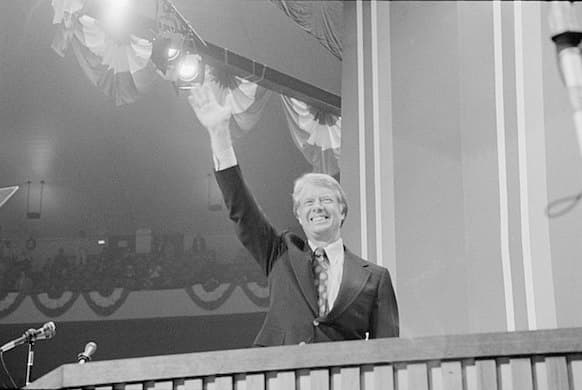Carters’ Open Door to Biographers May Be Helping Rehabilitate President’s Image
No Carter biographer has had to work like Robert Caro, an outsider who moved to Texas and carefully went to work on President Johnson’s friends and neighbors, proceeding from the periphery to the center of power.

Jimmy Carter and his clan are gaining ground on the Adams, Roosevelt, Bush, and Kennedy families. Written off as a failed president, Mr. Carter has been reborn in biography. The reasons why have to do with more than his post-presidential successes or even with redemptory portrayals of him as a consequential president.
Carterography begins with the president himself, the author of memoirs, fiction, poetry, and public policy tomes. His sister, Gloria, pitched in with “Away from Home: Letters to My Family” (Simon & Schuster 2008), written by the feisty matriarch, Lillian. Wayward brother Billy did not wait for a biographer, producing his own, “Billy Carter: A Journey Through the Shadows” (Taylor, 1999).
More is involved here than the Carters’ willingness to write about themselves. Mr. Carter campaigned, like so many presidential aspirants, against Washington as an “outlier” pledged to pursue, in today’s cant, “transparency” in governing and politics. He brought along with him a family that has lived as though they were helping the nation to write its own history.
Unlike the Kennedys, who shut out biographer Nigel Hamilton from the family archive after he published his first volume, “JFK: Reckless Youth” (1992), and before that gave insider biographer William Manchester (1963) a hard time, the Carters have been remarkably open to biographical scrutiny.
No Carter biographer has had to work like Robert Caro, an outsider who moved to Texas and carefully went to work on President Johnson’s friends and neighbors, proceeding from the periphery to the center of power in order to construct his riveting narratives of Johnson’s ascent to power.
Jonathan Alter, who wrote “His Very Best: Jimmy Carter: A Life” (Simon & Schuster, 2020), notes that he received the “extensive cooperation of Jimmy Carter and 18 members of his family,” including Rosalynn Carter, who shared her husband’s love letters. Also receiving considerable access to the Carters were E. Stanly Godbold Jr., author of “Jimmy & Rosalynn Carter: The Georgia Years, 1924-1974” (Oxford, 2020) and “Jimmy and Rosalyn Carter: Power and Human Rights, 1975-2020” (Oxford 2022), and Grant Hayter-Menzies, who wrote “Lillian Carter: A Compassionate Life” (McFarland, 2014)
Kai Bird, author of “The Outlier: The Unfinished Presidency of Jimmy Carter” (Crown, 2021), reports a degree of access and interest in biography that is truly remarkable:
“During our very first interview I complained that I couldn’t find anywhere in his presidential papers the private memoranda sent to him over the years by his lawyer and political adviser Charles Kirbo. Expressing surprise at this news, President Carter said he would look into the matter. Three days later, his longtime personal assistant and historian, Dr. Steven Hochman, called me to say that they had found the papers stored in cardboard boxes in Kirbo’s widow’s attic. Some months later I was given permission to read these voluminous letters and memos, written to Carter from 1962 all the way through his presidential term.”
Some biographers will bury in their acknowledgements how they acquire sources that can have a significant impact on the way they write their narratives and what they think of their subjects. The interaction between biographers and their subjects is, however, usually an untold story, except for the likes of a Boswell.
The resurgence of interest in Jimmy Carter, the person and president, is evident in the way biographers put Rosalynn Carter “in the room” during fateful decisions, emphasizing the president’s progressive environmental policies, climate change preparedness, reform of the judiciary, brokering the historic Israel and Egypt peace agreement, and post-presidential humanitarian projects.
The rehabilitation of Mr. Carter and his presidency accords with the rankings of American historians who have elevated Mr. Carter from the bottom to the top third of American presidents. Yet even the most sympathetic biographers and historians acknowledge his disastrous handling of the Iran hostage crisis, as well as his inconsistent political skills that led to electoral defeat.
What awaits the next Carter biographer? Perhaps taking issue with the notion that his presidency was “unfinished,” that it held out a promise that he could not fulfill. Much depends on what happens next. Presidents build on or dismantle their predecessors’ policies, as Ronald Reagan did when he removed Mr. Carter’s solar panels from the White House roof.
Mr. Rollyson is the author of “American Biography” and is working on a book about presidential biography.

